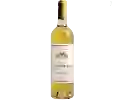
Château Sigalas RabaudNo. 5 Sans Soufre
In the mouth this white wine is a powerful mainly marked by the residual sugar.
This wine generally goes well with pork, vegetarian or poultry.
Taste structure of the No. 5 Sans Soufre from the Château Sigalas Rabaud
Light | Bold | |
Dry | Sweet | |
Soft | Acidic |
In the mouth the No. 5 Sans Soufre of Château Sigalas Rabaud in the region of Bordeaux is a powerful mainly marked by the residual sugar.
Food and wine pairings with No. 5 Sans Soufre
Pairings that work perfectly with No. 5 Sans Soufre
Original food and wine pairings with No. 5 Sans Soufre
The No. 5 Sans Soufre of Château Sigalas Rabaud matches generally quite well with dishes of pork, vegetarian or poultry such as recipes of stuffed mushrooms, quiche lorraine or quiche without pastry.
Details and technical informations about Château Sigalas Rabaud's No. 5 Sans Soufre.
Discover the grape variety: Gros Manseng
Gros Manseng blanc is a grape variety that originated in France (Netherlands). It produces a variety of grape specially used for wine making. It is rare to find this grape to eat on our tables. This variety of grape is characterized by medium-sized bunches and small grapes. Gros Manseng blanc can be found in several vineyards: South-West, Languedoc & Roussillon, Cognac, Bordeaux, Armagnac, Provence & Corsica, Rhone valley, Loire valley, Savoie & Bugey, Beaujolais.
Last vintages of this wine
The best vintages of No. 5 Sans Soufre from Château Sigalas Rabaud are 2017
Informations about the Château Sigalas Rabaud
The Château Sigalas Rabaud is one of of the world's greatest estates. It offers 9 wines for sale in the of Bordeaux to come and discover on site or to buy online.
The wine region of Bordeaux
Bordeaux, in southwestern France, is one of the most famous, prestigious and prolific wine regions in the world. The majority of Bordeaux wines (nearly 90% of the production Volume) are the Dry, medium and Full-bodied red Bordeaux blends for which it is famous. The finest (and most expensive) are the wines of the great châteaux of Haut-Médoc and the right bank appellations of Saint-Émilion and Pomerol. The former focuses (at the highest level) on Cabernet Sauvignon, the latter on Merlot.
The word of the wine: Rosé (champagne)
Unique rosé wine made by blending white wine with a small amount of red Champagne. It is however possible to vinify the must directly into rosé.














